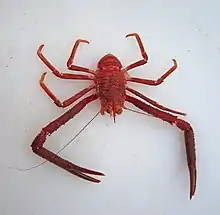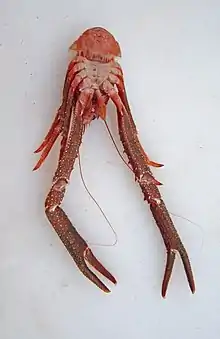Munida quadrispina
Munida quadrispina is a species of squat lobster. It was originally described to science by James E. Benedict in 1902.[1] This and other species of squat lobsters are sometimes referred to as "pinch bugs".[2]
| Munida quadrispina | |
|---|---|
 | |
| Scientific classification | |
| Kingdom: | |
| Phylum: | |
| Class: | |
| Order: | |
| Family: | |
| Genus: | |
| Species: | M. quadrispina |
| Binomial name | |
| Munida quadrispina Benedict, 1902 | |
Description

Munida quadrispina is brick red on its upper, dorsal side, and lighter colored underneath on its ventral side. The claws, chelipeds, are exceptionally long. There are small spines on the chelipeds. There are three pair of thin walking legs. The tail, telson, and large uropods on either side of the tail create a large tail fan. These animals can swim backwards rapidly by flexing their tail fan. The eyes are pigmented. The carapace of this animal may be up to 6.7 cm (2.6") long,[3] but the chellipeds may be several times longer.
Habitat
This squat lobster is found in Eastern Pacific waters from Sitka, Alaska to the Coronado Islands, Baja California, including Puget Sound.[3] It is found in water depths from 12 to 1463 meters. These animals favor rocky bottoms and rock faces in areas of low current. The low current often results in a silty habitat. There is evidence that this species can tolerate low oxygen concentrations.[4]
Life history
These crabs forage on the bottom, eating detritus, carrion, plankton, and benthic shrimp. They hide from predators in rock crevices and under cobbles. Their long claws allow them to feed from the safety of these recesses.[5] They are found on deep water sponges in British Columbia.[3] Unlike most other species of squat lobsters, Munida quadrispina juveniles are pelagic, swimming freely in the sea, foraging on plankton, before they mature and settle to the bottom.[6]
Edibility
There are commercial fisheries for several species of squat lobster, and even an experiment serving them at Long John Silver's,[7] but there is no commercial fishery for Munida quadrispina. This species is not listed in the Food and Drug Administration's Seafood List.[8] They are, however, occasionally caught in recreational prawn traps and adventurous chefs have prepared them as they might other crabs. They are reported good to eat.[9]
References
- Benedict, J.E. (1902). "Description of a new genus and forty six new species of crustaceans of the family Galatheidae with a list of the known marine species". Proceedings of the Biological Society of Washington. 26: 243–334. doi:10.5479/si.00963801.26-1311.243.
- "Munida quadrispina, pinch bug". www.sealifebase.ca. Retrieved 2018-07-04.
- Cowles, Dave. "Munida quadrispina". inverts.wallawalla.edu. Retrieved 2018-07-03.
- Burd and Binkhurst. "The Distribution of the Galatheid Crab Munida Quadrispina (Benedict 1902) in Relation to Oxygen Concentrations in British Columbia Fjords". Journal of Experimental Marine Biology and Ecology. 81: 1–20. doi:10.1016/0022-0981(84)90221-1.
- "Squat lobster, Deep Sea, Invertebrates, Munida spp at the Monterey Bay Aquarium". www.montereybayaquarium.org. Retrieved 2018-07-04.
- The biology of squat lobsters. Poore, Gary C. B., Ahyong, Shane T., Taylor, Joanne, Ph. D. Boca Raton, FL: CRC Press. 2011. ISBN 9781439866146. OCLC 671700636.CS1 maint: others (link)
- Hedlund, Steven (April 1, 2006). "Seafood FAQ: Langostino vs. Lobster: What's the difference?". Seafoodsource.com. Retrieved July 4, 2018.
- Nutrition, Center for Food Safety and Applied (2020-02-08). "Guidance for Industry: The Seafood List". U.S. Food and Drug Administration. Retrieved 2020-04-27.
- "Give Me Squat Lobsters, or Give Me Death!". ShipwreckRadio. 2012-08-21. Retrieved 2018-07-04.
External links
 Media related to Munida quadrispina at Wikimedia Commons
Media related to Munida quadrispina at Wikimedia Commons